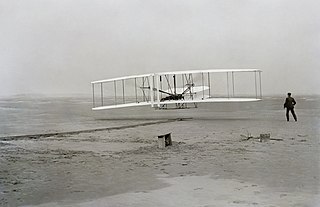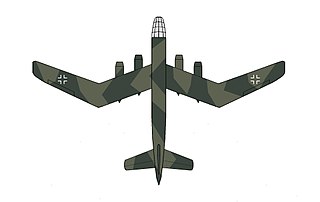
The Dornier Do 335Pfeil (Arrow) is a heavy fighter built by Dornier for Germany during World War II. The Pfeil's performance was predicted to be better than other twin-engine designs due to its unique push-pull configuration and the lower aerodynamic drag of the in-line alignment of the two engines. It was Nazi Germany's fastest piston-engined aircraft of World War II. The Luftwaffe was desperate to get the design into operational use, but delays in engine deliveries meant that only a handful were delivered before the war ended.

A T-tail is an empennage configuration in which the tailplane is mounted to the top of the fin. The arrangement looks like the capital letter T, hence the name. The T-tail differs from the standard configuration in which the tailplane is mounted to the fuselage at the base of the fin.

The Henschel Hs 132 was a World War II dive bomber and interceptor aircraft of the German Luftwaffe that never saw service. The unorthodox design featured a top-mounted BMW 003 jet engine and the pilot in a prone position. The Soviet Army occupied the factory just as the Hs 132 V1 was nearing flight testing, the V2 and V3 being 80% and 75% completed.

In aeronautical and naval engineering, pusher configuration is the term used to describe a drivetrain of air- or watercraft with propulsion device(s) after the engine(s). This is in contrast to the more conventional tractor configuration, which places them in front.

The empennage, also known as the tail or tail assembly, is a structure at the rear of an aircraft that provides stability during flight, in a way similar to the feathers on an arrow. The term derives from the French language verb empenner which means "to feather an arrow". Most aircraft feature an empennage incorporating vertical and horizontal stabilising surfaces which stabilise the flight dynamics of yaw and pitch, as well as housing control surfaces.
The EF 132 was a planned jet bomber, under development for the Luftwaffe during World War II. It was the last aircraft project development undertaken by Junkers during the war, and was the culmination of the Ju 287 design started in 1942.

A twin-boom aircraft has two longitudinal auxiliary booms. These may contain ancillary items such as fuel tanks and/or provide a supporting structure for other items. Typically, twin tailbooms support the tail surfaces, although on some types such as the Rutan Model 72 Grizzly the booms run forward of the wing. The twin-boom configuration is distinct from twin-fuselage designs in that it retains a central fuselage.

The Zeppelin-Staaken R.VI was a four-engined German biplane strategic bomber of World War I, and the only Riesenflugzeug design built in any quantity.

The Focke-Wulf Fw 42 was a design for a twin-engined medium bomber, of canard configuration, that was designed by Focke-Wulf Flugzeugbau AG in Germany in the early 1930s. Several air forces expressed interest in the aircraft. However, despite its advanced design being proven sound in wind tunnel testing, the Fw 42 failed to win a contract for development, and no examples of the type were ever built.

The SAI-Ambrosini SS.4 was an Italian fighter prototype developed in the late 1930s, featuring a canard-style wing layout and a pusher propeller. Development of the SS.4 was abandoned after the prototype crashed on its second flight.

The Arado Ar 81 was a German prototype dive bomber. Because the Reich Air Ministry decided to purchase the competing Junkers Ju 87, only three prototypes of the Ar 81 were completed.

The Zeppelin-Staaken Riesenflugzeuge were a series of very large bomber aircraft - Riesenflugzeuge, usually powered by four or more engines, designed and built in Germany from 1915 to 1919.
The Latécoère 225 was an unusual single seat canard microlight amphibian, with a swept wing, and of pusher configuration. It first flew in 1984 but was not put into production.

The Velocity V-Twin is an American twin engined, homebuilt aircraft, designed by Velocity Aircraft and following the layout of their earlier Velocity XL but with a single vertical tail. It is the flagship model of the Velocity Aircraft Line.
The Weymann W-1 was a French single seat biplane fighter aircraft, built during World War I. It had a most unusual layout, with an engine buried in the fuselage driving a pusher configuration propeller behind a cruciform tail. It was not successful and soon abandoned.

The Blohm & Voss Bv P 188 was a long-range, heavy jet bomber design project by the Blohm & Voss aircraft manufacturing division during the last years of the Third Reich. It featured a novel W-wing planform with variable incidence.
The Caproni Ca.66 was an Italian night bomber designed to reequip the post-World War I Italian Air Force. Only two examples of the four-engined biplane were built.
The Blohm & Voss P215 was an advanced jet night fighter project by Blohm & Voss during the Second World War. With a crew of three and twin jet engines, it featured a tailless swept-wing layout and heavy armament. An order for three prototypes was received just weeks before the war ended.

The Zeppelin-Lindau V I was a metal-framed, pusher configuration, German sesquiplane, designed by Claude Dornier. It flew on 13 November 1916 and crashed on the first flight.

The Convair Model 200 was a design for a supersonic vertical takeoff and landing (VTOL) fighter requirement for the United States Navy Sea Control Ship. Further versions were planned for conventional catapult launches and landing using the arresting gear.













